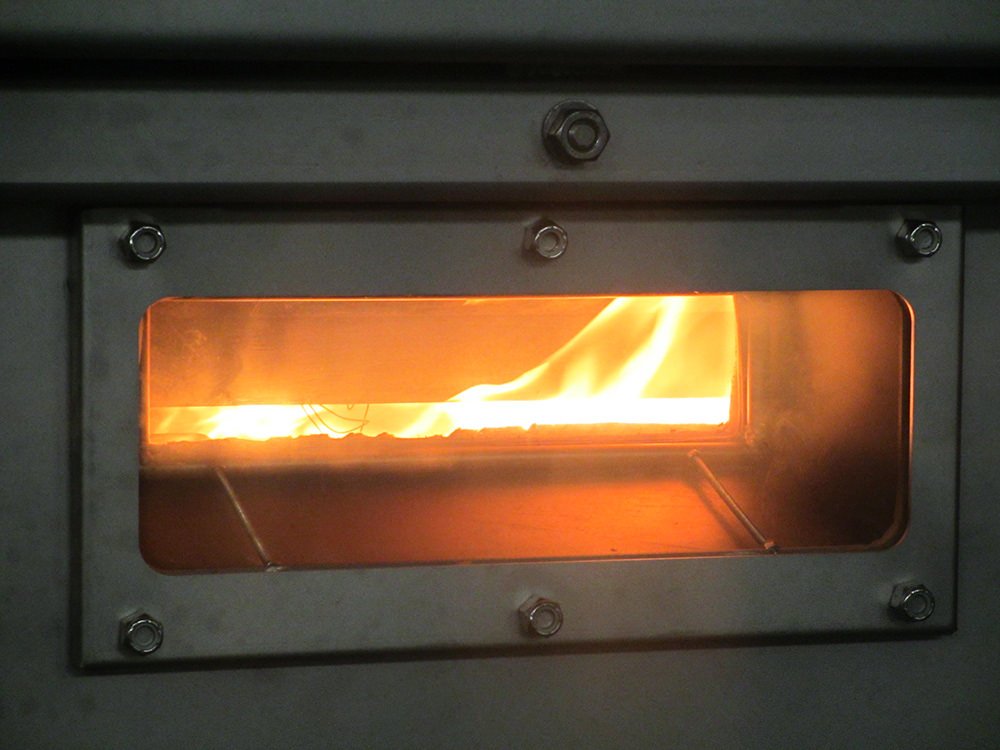UL 910 Steiner Tunnel
Compliance
UL 910, NFPA 262
The Steiner Tunnel is used to measure flame travel distance and optical density of smoke for insulated, jacketed, or both, electrical wires and cables and optical fiber cables that are to be installed in plenums and other spaces used to transport environmental air without being enclosed in raceways.
The National Electrical Code NEC 800 defines the fire ratings for cables, CMP, CMR, CMG, CM, CMX.
CMP cables are plenum cables, these cables are used if networking must be done in air ducts. They can be used for commercial or residential spaces. They will not combust and cannot actually cause fires.
CMR cables are riser cables. These are used for regular networking from room to room, as long as the cable does not need to pass through an air duct.
CM/CMG cables are the most commonly used commercial grade communication cable.
CMX is a residential grade cable. Such cables are limited to residential or other small applications where the number of communication cables used is very little.
UL 910 Steiner Tunnel Test
UL 910 Steiner Tunnel Furnace
CMP is the strictest cable in the NFPA/UL Fire Standard and the applicable safety standard is NFPA 262 / UL 910. The test provides for multiple specimens to be laid in the horizontal duct of the unit and burned for 20 minutes with an 87.9KW Gas Bunsen burner (300,000 BTU/Hr). The passing standard was that the flame should not extend beyond 5 feet from the front of the gas bunsen burner flame. This CMP cable is typically installed in air return pressurization systems used in ventilation ducts or air handling equipment and is approved for use in Canada and the USA. FEP/PLENUM materials conforming to NFPA 262 / UL 910 have better flame retardancy than low smoke and halogen-free materials conforming to IEC 60332-1 and IEC 60332-3, with a lower concentration of smoke on burning.
Steiner Tunnel consists of
Stainless steel SUS304 made Steiner Tunnel Furnace with firebrick interior for resistance to flame impact and good thermal insulation.
Double layer high-temperature-resistance glass observation window for observing and recording the flame spread distance.
Indicator for each glass windows for flame spread distance recording.
cooling water circulation support bracket to support burning coverings.
Equipped with a 2mm thick 304 stainless steel water sealing tank to ensure no leakage of smoke during the test.
Stainless steel insulation body top cover, filled with high-temperature-resistant insulation firebrick inside.
Independent multi-functional exhaust pressure detection device, real-time monitoring of exhaust pressure changes during the test. Measurement range of 0 to 250Pa, accuracy of ±0.5Pa, system schematic pressure test accuracy of ±2Pa.
Equips with a frequency converter to change the air velocity, with a flow rate capacity not less than 8000m3/h, to be able to discharge the smoke generated by the combustion of the sample in time to ensure the safety of the test.
U-Shaped gas burner, able to output a standard 5.3MJ/min flame source, and can be controlled by a flowmeter according to different standards, with a measuring range of 0 to 160L/min.
Equips with ignition system to ensure the safety performance of the test, high voltage igniter, 44KV, 50mA, minimum high voltage of 1.8kVp for the ignition electrode.
Smoke measurement system, provides a separate signal processing system to ensure that the sensor is linear.
Automatic recording of temperature and smoke sensing signals, with a sample collection frequency of 1Hz.
Standard test software for automatic recording of system air velocity, temperature, smoke density, and other test data.



